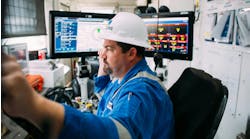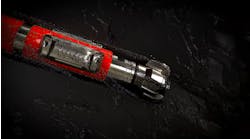Worldwide acceptance of underbalanced drilling (UBD) technologies has been slow in coming. Regulatory issues and overall industry pessimism have worked together to hinder any accelerated growth of these technologies. UBD may finally make an official world-wide debut in the coming 6-9 months.
The process has been lurking on land primarily, slowly improving, both technically and in terms of reliability. A few isolated, successful offshore jobs however, have been completed very safely, and with the expected results. One of the most important components of UBD operations is pressure control, and contrary to popular belief, the rotating pressure control technology now available is very reliable and boasts impressive operating statistics.
These successes, the need for "closer-to-fracture-gradient" drilling in some parts of the world, and increasing industry confidence in these technologies are generating a new merger and acquisition trend. Tool and service companies currently operating in the UBD market are starting to form new alliances, marketing agreements, and mergers and acquisitions processes to better position themselves within this quickly developing drilling market.
The face of this market (and the worldwide MWD/LWD service market) took on a new look in early October. The announcement of Precision Drilling Corporation's acquisition of Geoservices S.A.'s global directional drilling and electromagnetic measurement while drilling assets signaled yet another merging of compatible industry services.
The acquisition will allow Precision to further position itself in the approaching measurement while "underbalanced" drilling mar- ket. Included in the deal will be electromagnetic (EM) wave propagation resistivity, gamma ray, extended range EM tools, and wireless inter-tool telemetry capabilities. The inter-tool and extended range capabilities are key components to future UBD operations in deeper well environments.
Another key player in this particular sector of the upstream industry will be Weatherford International. The acquisitions of ECD Northwest (compressible drilling fluids), Williams Tool Company (rotating pressure control equipment), Dailey International (directional drilling tools and services), and Air Drilling Services (air drilling tools and services) signal a strong commitment to the fast-approaching increase in UBD activity.
The installation of a dual-gradient drilling system by the end of the year, or early in 2001, also signals an industry readying itself for a new era in drilling philosophy and "drilling with pressure" techniques.
Magnetic effects - no problem
Well construction operations have always budgeted time and money for a non-magnetic survey of some kind. Used as the final, definitive directional survey of a well, it can be acquired during the well construction phase or during post-well logging operations. Either way, this type of measurement takes valuable rig time to acquire.
Because of the relatively high service cost (not counting the rig time needed), and the need for more accurate open-hole surveys while drilling, a gyro-type measurement has always been looked at as the "holy grail" of directional while-drilling measurements.
One of the panel discussions (SPE Paper 63274, Development of a Robust Gyroscopic Orientation Tool for MWD Operations, 2000 SPE ATCE, October, 2000) at the recent SPE Annual Technical Conference and Exhibition in Dallas, Texas, featured a field-ready gyro for measurement while drilling applications. Considered to be one of the most elusive measurements in the oil industry, it may soon be emerging from the shadows.
Numerous gyro types have been studied over the past 20 years to evaluate their accuracy and most importantly, reliability in harsh environments (see table).
The gyro Baker Hughes INTEQ has chosen is the GBG device because of its apparent ruggedness in a harsh operational environmental. The paper describes an example where the military had used this particular type of gyro in guided submunitions intended for anti-tank warfare. One embedded (estimated shock > 10,000 g) gyro-containing intertial measurement unit was removed from the tank and returned to the lab where it was connected with cables and observed to work as normal.
The spinning mass, two-axis gyro operates in a spherical air bearing. This allows the device to be electronically, and mechanically, quiet. The device's ruggedness is achieved by a simple gas bearing, rotor-supporting mechanism while spinning. Temperature range for the development models peaked at 115
"Expanding" records and capabilities
Expandable tubular technology took ano-ther leap forward recently. The world's longest horizontal, openhole Expandable Sand Screen (ESS) was installed by Weatherford's Completion Systems division for BP in the Foinaven A field of the Faroe-Shetland basin. Run in 500 meters water depth from a semisubmersible rig, the 556-meter screen was expanded in a horizontal oil producing well to reduce highly anticipated sand production. Grahame Elliot, Senior Petroleum Engineer West of Shetland, BP stated: "The advantages included the elimination of the annulus between sand face and screen, potentially more effective future interventions and the potential future downsizing of wells."
This achievement, the recent installation of Enventure's 12th expandable casing string, and the introduction of e2Tech's first expandable tubular product, signal a coming renaissance in well engineering. Drilling, completion, and reservoir engineers are quickly gaining the ability to not only design using the conventional drill, complete, and sidetrack or re-complete method, but maybe using a simpler and cheaper (in the long run) drill-and-complete-only process. Reducing, and in some instances eliminating, the annulus between the screen and borehole wall, can reduce or eliminate sand control problems completely. Remove that possibility from the process and more dollars and resources can be focused on other important problems.


